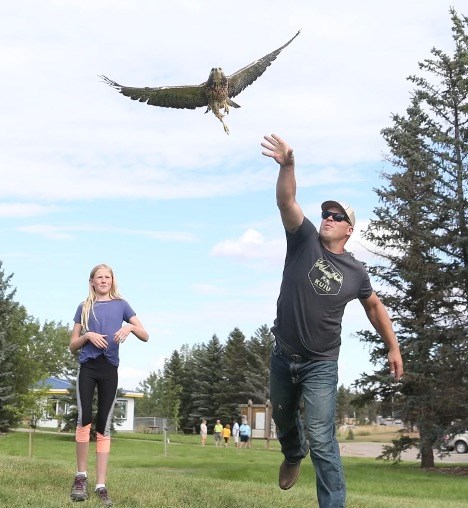Albertan, Colin Weir, described his “aha moment,” when he suddenly realized what it was he wanted to do with the rest of his life - he wanted to live and work with raptors.
The path he took to discovery of his life’s passion wasn’t exactly as the crow flies – more like as the peregrine plunges – but he eventually was able to open the Birds of Prey Centre in Coaldale, Alberta, where he estimates they have as many as 200 birds.
His Alberta Birds of Prey Nature Centre has been taking in raptors of all descriptions for nearly 40 years. Some of the birds are rehabilitated for eventual return to the wild while others become permanent residents.
Weir has an American Kestrel and a Saw-whet Owl. Basil the Borrowing Owl is a member of an endangered species. In the wild they take over abandoned badger holes, and will eat a lot of mice and grasshoppers.
“He was actually hatched in our facility and we use him in our environmental learning programs,” Weir said.
Sarah the Golden Eagle was injured too badly to qualify for re-release. She’s 40 years old, so is getting up near the high end of a typical lifespan.
“It’s survival of the fittest you know, so they've got to learn how to catch their own food and hunt and survive on their own, Weir said.
“And so sometimes they just might not have the natural hunting abilities and survival skills to go out there and be self self-sufficient.”
The centre receives no operating funding from any government agencies. They depend on admissions and the generous help from donations to stay afloat.
They do get some funding from the province of Alberta and the federal government for some periodic capital projects.
But mostly it’s a hand-to-mouth operation, especially with 200 mouths to feed every day.
“I’m poor but happy,” Weir said with a smile.
It’s the educational aspect of the presentations that keeps him motivated. Raptors are treated much better now than they were a few years ago.
“Going back 70 or 80 years ago, in much of North America it was legal to shoot eagles and other birds of prey,” he said.
“The reason was If you're a bird watcher over 100 years ago, the only way you got credit for seeing a bird is if you shot it and brought it back dead.”
Others shot the raptors to collect feathers for their hats.
“So it just show shows you how valuable and important environmental learning is. We’re continuing that tradition and it's a bit of a passion with us,” Weir said.
Weir’s three children are in their early 20s, the age when most young adults are looking to decide what they want to do with their lives. They’re used to having birds of various descriptions in and around the house.
Weir hopes some young people who visit the centre or his off-site presentations are as moved as he was about a half century ago when he visited his grandmother in Coventry, England.
At the time he knew he wanted to work in a field where he could feel like he was giving something back – some kind of community service – but didn’t know exactly how.
At a presentation at a town fair, he met his forever passion.
“As soon as I saw that guy with a falcon on his arm, my life just took a 90 degree turn,” he said.
“Then when I discovered birds of prey and falconry and nature conservation, I set out on this career path and it's almost like an obsession to rehabilitate and release injured birds of prey,” he said.
Weir was particularly interested in singling out two elected officials as key players in helping to make his dream a reality. He said he couldn’t have opened his Centre without the help of his MLA and the minister of fish and wildlife.
When he was launching his idea in 1982 there was no provision in the Provincial Wildlife Act for private citizens to help injured wildlife in captivity. Wildlife rescue and rehabilitation in Western Canada was almost non-existent.
Weir and co-founder Wendy Slaytor approached the province with an offer to start Alberta’s first volunteer wildlife rescue facility.
At that time, there were no government provisions for private individuals to possess wildlife, even for the purposes of rehabilitation. A very supportive MLA Bob Bogle worked with then Fish & Wildlife Minister Don Sparrow to grant special ministerial permission for them to start their back yard volunteer wildlife rescue facility, the Alberta Birds of Prey Foundation.
At Discovery Days in Cochrane recently, Weir saw something of a younger version of himself in Isaiah Vonesch, who’s mom described as “as passionate a birder as you will ever meet.”
If a smile is an accurate gauge of that, his 1000 watts was proof, as he held Willow the Great Horned Owl as others took photos.




